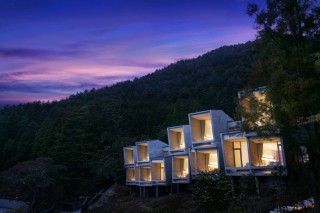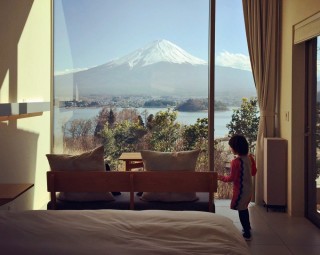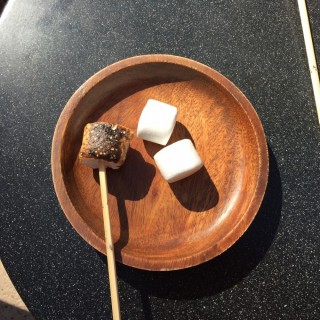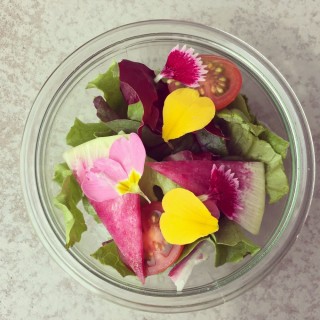Loading
Search
▼ Minimalist Family ‘Camping’ In The Foothills of Mount Fuji
- Category:Mountain
The birds are singing, the wind is rustling in the forest and sunlight is filtering through the treetops. So far, so idyllic — until my 3-year-old releases a primal bird-scattering shriek as she thrusts an axe into a piece of wood.
This may sound like a scene from a horror movie. The reality, however, is a little less scary. My daughter’s dangerous weapon-wielding belies the fact we in the heart of one of Japan’s most intriguing new hotels,
Hoshinoya Fuji, the latest addition to Japan’s leading design hotel group Hoshino Resorts. It is the fourth member of the high-end Hoshinoya collection, with sister hotels already open in Karuizawa, Kyoto and Okinawa.
The concept is simple: The new hotel proclaims itself to be “Japan’s first glamping resort,” referencing an increasingly popular buzzword used to describe a luxury take on conventional camping.
Located on a forested mountainside near Lake Kawaguchi, with close-up Technicolor views of Mount Fuji, it offers al fresco dining, horseback riding, marshmallow toasting, sunrise canoeing, star gazing — not to forget wood-chopping masterclasses.
This may sound like a scene from a horror movie. The reality, however, is a little less scary. My daughter’s dangerous weapon-wielding belies the fact we in the heart of one of Japan’s most intriguing new hotels,
Hoshinoya Fuji, the latest addition to Japan’s leading design hotel group Hoshino Resorts. It is the fourth member of the high-end Hoshinoya collection, with sister hotels already open in Karuizawa, Kyoto and Okinawa.
The concept is simple: The new hotel proclaims itself to be “Japan’s first glamping resort,” referencing an increasingly popular buzzword used to describe a luxury take on conventional camping.
Located on a forested mountainside near Lake Kawaguchi, with close-up Technicolor views of Mount Fuji, it offers al fresco dining, horseback riding, marshmallow toasting, sunrise canoeing, star gazing — not to forget wood-chopping masterclasses.
Sleeping at the hotel, however, is a far cry from crawling into a damp tent. Instead, guests stay inside one of the 40 luxuriously minimal concrete “cabins” scattered across the mountainside. And, perhaps best of all, the hotel claims to be resolutely family friendly. I was keen to put this to the test. The arrival of two babies in the previous few years had halted the camping forays my husband and I once enjoyed in Japan’s forests and far-flung islands.
The mix of contemporary design and glamping culture struck me as the perfect setting to introduce my 3-year-old daughter, Kiko, to the joys of camping (minus the usual discomforts).
After two train rides from Tokyo, plus a short taxi hop from Kawaguchiko Station, we finally arrive at the reception, a glass-fronted, hut-like building with an entire wall covered in a colorful display of stylishly utilitarian canvas bags.
Smiling staff ask which bags my daughter and I would like to use — I opt for the gray and Kiko’s face lights up when she sees a small pink children’s version — with each containing an assortment of camping goodies, such as headlamps and binoculars.
Jumping into a jeep, we drive for a few minutes to the hotel grounds where we are greeted by the ever-friendly Natsumi Nagase, one of a team of young Glamping Masters looking after guests. Before we can catch our breath, we follow her up a narrow pathway into the forest, which leads to the hotel’s Cloud Terrace, a string of wooden platforms scattered among the trees.
Our first stop is a camping table set for lunch, and decorated with piles of wild flowers, surrounded by canvas chairs covered in cozy blankets.
We are handed striped aprons and led to another nearby table covered in bowls of mountain vegetables, herbs, cheeses and cooked meats.
“Here you go,” says Nagase as she passes us two balls of dough. “It’s time to make pizzas.” Glamping, it seems, involves working for your lunch.
The “p” word causes Kiko’s eyes to light up — and she proceeds to arrange cheese, tomato sauce and sausages into the shape of a unicorn, complete with a takenoko bamboo shoot for a horn.
We cook the pizzas in a small clay Dutch oven nearby before devouring them at the table. After several rounds, washed down with delicious local grape juice, we are full and happy — our contentedness complete as we glance up and see a heart-shaped patch of sky between the treetops.
“A previous guest spotted that, too,” says Nagase with a laugh. “We didn’t plan it — it’s a coincidence. But it fits in perfectly.” Next, it’s time to check into our cabin. Wandering down the forested hillside, we pass the main building before continuing on to rows of starkly minimal concrete cubes with angular glass facades, stacked two-storys high into the mountainside.
Finally, we arrive. The large wooden door slides open and the interior unfolds in a burst of white light. A wall of glass at the far end frames a perfect close-up view of Mount Fuji surrounded by still lake waters and dense green forest.
“You’re lucky today,” says Nagase. “The weather here is very changeable. You can probably see Mount Fuji 60 percent of the time.” The room is a textbook example of contemporary Japanese design: minimal white decor, light wood furnishings, subtly sloping ceilings to enhance the sense of space, a wood grain imprint in the concrete.
Best of all is the terrace, with its sunken kotatsu (heated table), piles of supersoft blankets and a small “campfire” that appears to hover above the concrete.
Other nods to camping include Wellington boots for guests (green Crocs for kids), titanium Snow Peak cups on the wall, a thermos containing local herb tea, and up-market cans of sweet chestnuts and chili con carne in the fridge. And it’s all resolutely child-friendly, as reflected in the safety guard Nagase adds to Kiko’s side of the bed and the netting she fixes on the terrace — plus the teddy bear toiletry kit.
Tempting as it is to simply luxuriate in the minimal serenity of it all, Kiko is already jumping on the bed. It’s time to explore. We venture up the hillside, learning the hard way that it’s a long, steep walk for a 3-year-old. Kiko clambers on my back to board what becomes known as the “mummy taxi,” and I lug her up the hill.
Venturing along forest pathways, the afternoon passes in a blur of explorations. We find a round tent filled with Moroccan-style cushions where we rest for a while; we stumble across a clearing with artfully coiled twigs that are used for games of hoops; and, finally, we head to the hub of the Cloud Terrace, a sleek wooden deck with seating around an open-air fire.
Adjacent to the terrace is a glass-fronted library, complete with a wall of books, a burning stove and modern white lanterns, where I sit and sip tea as Kiko makes dolls from cotton and dried lavender. Next, we move to the outdoor campfire where Kiko discovers her new favorite thing: toasting marshmallows.
The mix of contemporary design and glamping culture struck me as the perfect setting to introduce my 3-year-old daughter, Kiko, to the joys of camping (minus the usual discomforts).
After two train rides from Tokyo, plus a short taxi hop from Kawaguchiko Station, we finally arrive at the reception, a glass-fronted, hut-like building with an entire wall covered in a colorful display of stylishly utilitarian canvas bags.
Smiling staff ask which bags my daughter and I would like to use — I opt for the gray and Kiko’s face lights up when she sees a small pink children’s version — with each containing an assortment of camping goodies, such as headlamps and binoculars.
Jumping into a jeep, we drive for a few minutes to the hotel grounds where we are greeted by the ever-friendly Natsumi Nagase, one of a team of young Glamping Masters looking after guests. Before we can catch our breath, we follow her up a narrow pathway into the forest, which leads to the hotel’s Cloud Terrace, a string of wooden platforms scattered among the trees.
Our first stop is a camping table set for lunch, and decorated with piles of wild flowers, surrounded by canvas chairs covered in cozy blankets.
We are handed striped aprons and led to another nearby table covered in bowls of mountain vegetables, herbs, cheeses and cooked meats.
“Here you go,” says Nagase as she passes us two balls of dough. “It’s time to make pizzas.” Glamping, it seems, involves working for your lunch.
The “p” word causes Kiko’s eyes to light up — and she proceeds to arrange cheese, tomato sauce and sausages into the shape of a unicorn, complete with a takenoko bamboo shoot for a horn.
We cook the pizzas in a small clay Dutch oven nearby before devouring them at the table. After several rounds, washed down with delicious local grape juice, we are full and happy — our contentedness complete as we glance up and see a heart-shaped patch of sky between the treetops.
“A previous guest spotted that, too,” says Nagase with a laugh. “We didn’t plan it — it’s a coincidence. But it fits in perfectly.” Next, it’s time to check into our cabin. Wandering down the forested hillside, we pass the main building before continuing on to rows of starkly minimal concrete cubes with angular glass facades, stacked two-storys high into the mountainside.
Finally, we arrive. The large wooden door slides open and the interior unfolds in a burst of white light. A wall of glass at the far end frames a perfect close-up view of Mount Fuji surrounded by still lake waters and dense green forest.
“You’re lucky today,” says Nagase. “The weather here is very changeable. You can probably see Mount Fuji 60 percent of the time.” The room is a textbook example of contemporary Japanese design: minimal white decor, light wood furnishings, subtly sloping ceilings to enhance the sense of space, a wood grain imprint in the concrete.
Best of all is the terrace, with its sunken kotatsu (heated table), piles of supersoft blankets and a small “campfire” that appears to hover above the concrete.
Other nods to camping include Wellington boots for guests (green Crocs for kids), titanium Snow Peak cups on the wall, a thermos containing local herb tea, and up-market cans of sweet chestnuts and chili con carne in the fridge. And it’s all resolutely child-friendly, as reflected in the safety guard Nagase adds to Kiko’s side of the bed and the netting she fixes on the terrace — plus the teddy bear toiletry kit.
Tempting as it is to simply luxuriate in the minimal serenity of it all, Kiko is already jumping on the bed. It’s time to explore. We venture up the hillside, learning the hard way that it’s a long, steep walk for a 3-year-old. Kiko clambers on my back to board what becomes known as the “mummy taxi,” and I lug her up the hill.
Venturing along forest pathways, the afternoon passes in a blur of explorations. We find a round tent filled with Moroccan-style cushions where we rest for a while; we stumble across a clearing with artfully coiled twigs that are used for games of hoops; and, finally, we head to the hub of the Cloud Terrace, a sleek wooden deck with seating around an open-air fire.
Adjacent to the terrace is a glass-fronted library, complete with a wall of books, a burning stove and modern white lanterns, where I sit and sip tea as Kiko makes dolls from cotton and dried lavender. Next, we move to the outdoor campfire where Kiko discovers her new favorite thing: toasting marshmallows.
Fortunately, she is able to let off some of her sugar-high steam with the arrival of another Glamping Master, expert wood chopper Satoshi Chishiro.
After demonstrating his skills with samurai-like precision, he gives Kiko an impromptu lesson, handing her a wide mountain knife known as a nata, which is normally used with smaller pieces of wood. Holding my breath as she waves the knife with wild abandon above her, she slams it into the logs with surprising (possibly marshmallow-fueled) power.
The exercise and fresh air make us hungry and we head for an early dinner in the vaulted wooden dining room. Here, I tuck into a pretty and imaginative set meal, with highlights including an unexpectedly tender steak of deer meat from the slopes of Mount Fuji plus an assortment of rainbow-bright salads.
Kiko devours her children’s meal — beef burger, prawn tempura, corn soup and rice, all served on handcrafted wood plates and bowls — which culminates in the staff bringing her a small wooden house.
After demonstrating his skills with samurai-like precision, he gives Kiko an impromptu lesson, handing her a wide mountain knife known as a nata, which is normally used with smaller pieces of wood. Holding my breath as she waves the knife with wild abandon above her, she slams it into the logs with surprising (possibly marshmallow-fueled) power.
The exercise and fresh air make us hungry and we head for an early dinner in the vaulted wooden dining room. Here, I tuck into a pretty and imaginative set meal, with highlights including an unexpectedly tender steak of deer meat from the slopes of Mount Fuji plus an assortment of rainbow-bright salads.
Kiko devours her children’s meal — beef burger, prawn tempura, corn soup and rice, all served on handcrafted wood plates and bowls — which culminates in the staff bringing her a small wooden house.
Tentatively lifting off the roof, she grins as she spies star-shaped cakes and a tube of chocolate sauce for her to squeeze over them. After catching the mummy taxi back to the room, Kiko has a quick bath before falling into a deep slumber, which gives me a few quiet hours to admire the beauty of a moonlit Mount Fuji from the terrace. We have an early start the next morning. After a few bites of fresh fruit and bread, we are driven to nearby Lake Kawaguchi, where a local takes us out on a canoe.
The conditions are as perfect as the setting is beautiful: The iconic triangular form of the mountain is reflected with crystal clarity on the surface of still waters.
As we paddle across the near-empty lake, past an island covered in green forests and a red Shinto torii gate, Kiko sits and sings quietly to herself.
Back at the hotel, a wooden “Morning Box” is delivered to our terrace and we indulge in an outdoor-style picnic of breads, Spanish omelettes, flasks of soup, yogurts and fresh fruit.
Even the salads — sprinkled with edible flowers — are strikingly pretty, prompting Kiko to ask, “Why are there butterflies in my salad?”
The last few hours are spent in the forest around the Cloud Terrace, as we enjoy a yoga-style stretching session beneath the trees on a spacious wooden deck dotted with modernist rocking chairs. And then, it’s time to head back to reality. After giving Nagase a bear hug, Kiko clambers into the car and, as we pull away, voices perhaps the best hotel critique possible from a 3-year-old: “Can we come back again? I want to eat more marshmallows.”
Hoshinoya Fuji is (050-3786-1144) is located 20 minutes by car (or taxi) from Kawaguchiko Station, which is roughly 2.5 hours from Tokyo Station. Cabins are ¥51,000 during low season and ¥135,000 during high.
For more information, visit hoshinoyafuji.com/en. For those who prefer to book transport and accommodation at once, or as part of a wider Japan trip, Inside Japan (www.insidejapantours.com) can tailor an array of trips to suit all budgets and interests. Danielle Demetriou was hosted thanks to Hoshinoya Fuji, travel expenses to and from Tokyo were covered by Inside Japan.
The conditions are as perfect as the setting is beautiful: The iconic triangular form of the mountain is reflected with crystal clarity on the surface of still waters.
As we paddle across the near-empty lake, past an island covered in green forests and a red Shinto torii gate, Kiko sits and sings quietly to herself.
Back at the hotel, a wooden “Morning Box” is delivered to our terrace and we indulge in an outdoor-style picnic of breads, Spanish omelettes, flasks of soup, yogurts and fresh fruit.
Even the salads — sprinkled with edible flowers — are strikingly pretty, prompting Kiko to ask, “Why are there butterflies in my salad?”
The last few hours are spent in the forest around the Cloud Terrace, as we enjoy a yoga-style stretching session beneath the trees on a spacious wooden deck dotted with modernist rocking chairs. And then, it’s time to head back to reality. After giving Nagase a bear hug, Kiko clambers into the car and, as we pull away, voices perhaps the best hotel critique possible from a 3-year-old: “Can we come back again? I want to eat more marshmallows.”
Hoshinoya Fuji is (050-3786-1144) is located 20 minutes by car (or taxi) from Kawaguchiko Station, which is roughly 2.5 hours from Tokyo Station. Cabins are ¥51,000 during low season and ¥135,000 during high.
For more information, visit hoshinoyafuji.com/en. For those who prefer to book transport and accommodation at once, or as part of a wider Japan trip, Inside Japan (www.insidejapantours.com) can tailor an array of trips to suit all budgets and interests. Danielle Demetriou was hosted thanks to Hoshinoya Fuji, travel expenses to and from Tokyo were covered by Inside Japan.
- April 22, 2016
- Comment (0)
- Trackback(1)





